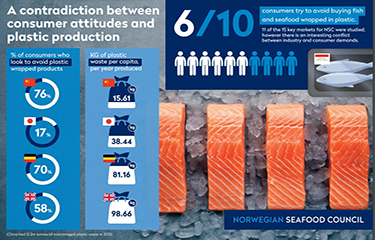Consumers avoiding seafood wrapped in plastic, Norwegian Seafood Council says

A recent international study conducted by the Norwegian Seafood Council found 60 percent of consumers avoid buying fish that comes wrapped in plastic.
The Norwegian Seafood Council (NSC), a trade group designed to promote Norwegian seafood abroad and to tout the nutritional benefits and sustainability credentials associated with seafood from Norway, said the study surveyed 15,000 consumers in 15 countries, and provided both overall and nation-by-nation results. Seven out of 10 of those surveyed said they believe it is important that seafood be packaged in recyclable materials, but 60 percent said it is often difficult to know if packaging can be recycled.
“Over recent decades, we have quickly adapted to living throwaway lifestyles. However, climate change and issues with plastic waste have thankfully made their way to the top of world leader’s agendas,” Norwegian Seafood Council Consumer Analyst Lark Moksness said. “Consumers are recognizing the impact their daily lives have on the planet – something that increasingly applies to their food choices and their fish choices. We’ve seen a positive rise in people thinking about where their fish comes from. And now they are also considering the packaging their seafood comes in – with many trying to avoid plastic-wrapped fish and seafood and seeking out recycled options.”
In Thailand, 77 percent of consumers avoid buying seafood wrapped in plastic, and the figure is 76 percent in China, 70 percent in Germany, 58 percent in the U.K., 35 percent in Sweden, 31 percent in Norway, and 17 percent in Japan.
“Our research indicates that more could be done to educate shoppers on the materials their fish is packaged in,” Moksness said. "There’s a clear desire from consumers to be ‘doing more’ and changing behaviors where packaging is concerned. Minimizing plastic usage – especially single use plastics which are so often used in food packaging – is one of the simplest ways of creating a more sustainable future.”
The U.N. Environmental Program (UNEP) reports around 400 million tons of plastic waste is produced annually worldwide. Approximately 36 percent of all plastics produced are used in packaging, including single-use plastic products for food and beverage containers, according to the NSC.
“For someone who works alongside the seafood industry, with a deep passion for environmental change, [the results are] extremely promising. However, changing consumer behavior at scale can be immensely challenging. We have seen in recent years the increasing desire for convenience, yet with this has come a higher dependence on single use plastics,” Moksness said. “We need a multi-pronged solution. One that sees a greater focus on providing a holistic view on sustainability. From distributors to retailers, to communicators and consumers, we all need to assess our need for plastic usage. As our survey suggests, consumer desire to change is growing, it’s all pointing in the right direction, and we encourage industries to take hold of this, and work towards a greener future together.”
Image courtesy of Norwegian Seafood Council





Share